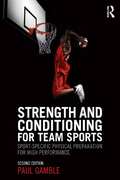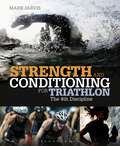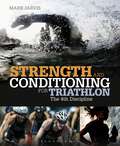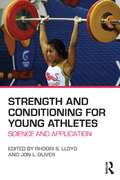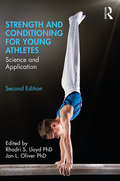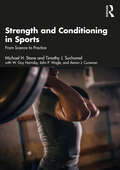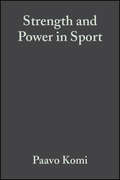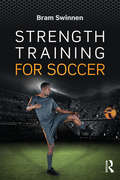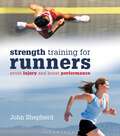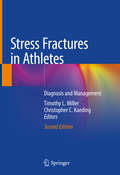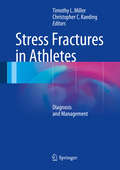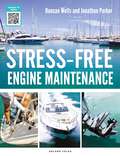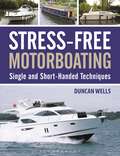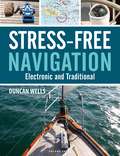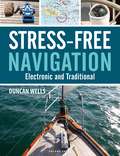- Table View
- List View
Strength and Conditioning for Team Sports: Sport-Specific Physical Preparation for High Performance, second edition
by Paul GambleStrength and Conditioning for Team Sports is designed to help trainers and coaches to devise more effective high-performance training programs for team sports. This remains the only evidence-based study of sport-specific practice to focus on team sports and features all-new chapters covering neuromuscular training, injury prevention and specific injury risks for different team sports. Fully revised and updated throughout, the new edition also includes over two hundred new references from the current research literature. The book introduces the core science underpinning different facets of physical preparation, covering all aspects of training prescription and the key components of any degree-level strength and conditioning course, including: physiological and performance testing strength training metabolic conditioning power training agility and speed development training for core stability training periodisation training for injury prevention Bridging the traditional gap between sports science research and practice, each chapter features guidelines for evidence-based best practice as well as recommendations for approaches to physical preparation to meet the specific needs of team sports players. This new edition also includes an appendix that provides detailed examples of training programmes for a range of team sports. Fully illustrated throughout, it is essential reading for all serious students of strength and conditioning, and for any practitioner seeking to extend their professional practice.
Strength and Conditioning for Team Sports: Sport-Specific Physical Preparation for High Performance, second edition
by Paul GambleStrength and Conditioning for Team Sports is designed to help trainers and coaches to devise more effective high-performance training programs for team sports. This remains the only evidence-based study of sport-specific practice to focus on team sports and features all-new chapters covering neuromuscular training, injury prevention and specific injury risks for different team sports. Fully revised and updated throughout, the new edition also includes over two hundred new references from the current research literature. The book introduces the core science underpinning different facets of physical preparation, covering all aspects of training prescription and the key components of any degree-level strength and conditioning course, including: physiological and performance testing strength training metabolic conditioning power training agility and speed development training for core stability training periodisation training for injury prevention Bridging the traditional gap between sports science research and practice, each chapter features guidelines for evidence-based best practice as well as recommendations for approaches to physical preparation to meet the specific needs of team sports players. This new edition also includes an appendix that provides detailed examples of training programmes for a range of team sports. Fully illustrated throughout, it is essential reading for all serious students of strength and conditioning, and for any practitioner seeking to extend their professional practice.
Strength and Conditioning for Triathlon: The 4th Discipline
by Mark JarvisStrength & Conditioning for Triathlon is an accessible, practical introduction to strength and conditioning for endurance sports, dispelling many of the myths which have led to misunderstanding and misuse of the techniques in the past. With specific chapters on injury prevention, the swim, the cycle and the run, this ideal triathlon companion gives detailed and practical examples of how each aspect of your programme can be enhanced. Each chapter includes information on how strength and conditioning will impact on you, the scientific evidence (in practical language) to support the claims, how much you can expect to gain and practical examples of how to implement the training. An indispensable practical guide, it looks at how to plan your strength and conditioning training throughout the calendar and how to incorporate this work into your regular triathlon training. It also provides a comprehensive resource of conditioning exercises, strength exercises and running drills, all of which are fully illustrated so you can guarantee great technique.This is the essential companion to anyone wishing to improve their triathlon results.
Strength and Conditioning for Triathlon: The 4th Discipline
by Mark JarvisStrength & Conditioning for Triathlon is an accessible, practical introduction to strength and conditioning for endurance sports, dispelling many of the myths which have led to misunderstanding and misuse of the techniques in the past. With specific chapters on injury prevention, the swim, the cycle and the run, this ideal triathlon companion gives detailed and practical examples of how each aspect of your programme can be enhanced. Each chapter includes information on how strength and conditioning will impact on you, the scientific evidence (in practical language) to support the claims, how much you can expect to gain and practical examples of how to implement the training. An indispensable practical guide, it looks at how to plan your strength and conditioning training throughout the calendar and how to incorporate this work into your regular triathlon training. It also provides a comprehensive resource of conditioning exercises, strength exercises and running drills, all of which are fully illustrated so you can guarantee great technique.This is the essential companion to anyone wishing to improve their triathlon results.
Strength and Conditioning for Young Athletes: Science and application
by Rhodri S. Lloyd Jon L. OliverStrength and Conditioning for Young Athletes offers an evidence-based introduction to the theory and practice of strength and conditioning for children and young athletes. Drawing upon leading up-to-date research in all aspects of fitness and movement skill development, the book adopts a holistic approach to training centred on the concept of long-term athletic development and the welfare of the young athlete. While other textbooks focus on a single aspect of youth trainability, this book explores every key topic in strength and conditioning as applied to young people, including: talent identification motor skill development strength, power and plyometrics speed and agility metabolic conditioning mobility and flexibility periodization weightlifting myths overtraining and injury prevention nutrition. Written by a team of leading international strength and conditioning experts and paediatric sport scientists, every chapter includes programming guidelines for youths throughout childhood and adolescence to show how the latest scientific research can be applied by coaches to optimize young athletic potential. This is an essential resource for all students of strength and conditioning or paediatric exercise science, as well as any coach or athletic trainer working with children and young people.
Strength and Conditioning for Young Athletes: Science and application
by Rhodri S. Lloyd Jon L. OliverStrength and Conditioning for Young Athletes offers an evidence-based introduction to the theory and practice of strength and conditioning for children and young athletes. Drawing upon leading up-to-date research in all aspects of fitness and movement skill development, the book adopts a holistic approach to training centred on the concept of long-term athletic development and the welfare of the young athlete. While other textbooks focus on a single aspect of youth trainability, this book explores every key topic in strength and conditioning as applied to young people, including: talent identification motor skill development strength, power and plyometrics speed and agility metabolic conditioning mobility and flexibility periodization weightlifting myths overtraining and injury prevention nutrition. Written by a team of leading international strength and conditioning experts and paediatric sport scientists, every chapter includes programming guidelines for youths throughout childhood and adolescence to show how the latest scientific research can be applied by coaches to optimize young athletic potential. This is an essential resource for all students of strength and conditioning or paediatric exercise science, as well as any coach or athletic trainer working with children and young people.
Strength and Conditioning for Young Athletes: Science and Application
by Rhodri S. Lloyd Jon L. OliverStrength and Conditioning for Young Athletes: Science and Application offers an evidence-based introduction to the theory and practice of strength and conditioning for young athletes. Fully revised and updated, this second edition draws on leading research to offer a holistic approach to training centred on the concept of long-term athletic development and the welfare of the young athlete. With 20 new authors and 8 new chapters, the book explores every key topic in strength and conditioning applied to young athletes, including: Growth and maturation Talent identification and talent development Monitoring and assessment Coaching young athletes Motor skill development Strength development and plyometrics Speed and agility development Metabolic conditioning Mobility and flexibility Periodisation and nutritional strategies Injury prevention and wellbeing Developing a holistic programme for young athletes. Written by a team of leading international strength and conditioning experts and paediatric sport scientists, the book includes expanded practical guidelines in every chapter to show how the latest scientific research can be applied by coaches to optimise young athletic potential. Including sample training programmes and exercises throughout, this is an essential resource for all students of strength and conditioning or paediatric exercise science, as well as any coach and athletic trainer working with children and young people.
Strength and Conditioning for Young Athletes: Science and Application
by Rhodri S. Lloyd Jon L. OliverStrength and Conditioning for Young Athletes: Science and Application offers an evidence-based introduction to the theory and practice of strength and conditioning for young athletes. Fully revised and updated, this second edition draws on leading research to offer a holistic approach to training centred on the concept of long-term athletic development and the welfare of the young athlete. With 20 new authors and 8 new chapters, the book explores every key topic in strength and conditioning applied to young athletes, including: Growth and maturation Talent identification and talent development Monitoring and assessment Coaching young athletes Motor skill development Strength development and plyometrics Speed and agility development Metabolic conditioning Mobility and flexibility Periodisation and nutritional strategies Injury prevention and wellbeing Developing a holistic programme for young athletes. Written by a team of leading international strength and conditioning experts and paediatric sport scientists, the book includes expanded practical guidelines in every chapter to show how the latest scientific research can be applied by coaches to optimise young athletic potential. Including sample training programmes and exercises throughout, this is an essential resource for all students of strength and conditioning or paediatric exercise science, as well as any coach and athletic trainer working with children and young people.
Strength and Conditioning in Sports: From Science to Practice
by Michael H. Stone Timothy J. Suchomel W. Guy Hornsby John P Wagle Aaron J. CunananA good sport scientist and coach must understand both the underlying mechanisms and the practical application of training principles. Strength and Conditioning in Sports: From Science to Practice is unique in that it covers both of these areas in a comprehensive manner. This textbook "connects" the mechanism with practical application. Selecting the appropriate training process is paramount to success in competitive sport. A major component of this textbook is the detailed explanations of developing that process from creating an annual plan, selection of the appropriate periodization model and how to program that model. In application, connecting physiology to performance can be enhanced by using appropriate athlete monitoring techniques. Although there can be overlap, monitoring can be divided into two components: fatigue management and program efficacy. One of the features of this text is the in-depth description of how the monitoring process should take place and how monitoring data can be used in program application. This exciting new text provides a comprehensive overview of the application of science to sport and will be key reading for undergraduate and postgraduate students of strength and conditioning, athletic training, exercise physiology, human performance, personal training, and other related disciplines of sport science and kinesiology.
Strength and Conditioning in Sports: From Science to Practice
by Michael H. Stone Timothy J. Suchomel W. Guy Hornsby John P Wagle Aaron J. CunananA good sport scientist and coach must understand both the underlying mechanisms and the practical application of training principles. Strength and Conditioning in Sports: From Science to Practice is unique in that it covers both of these areas in a comprehensive manner. This textbook "connects" the mechanism with practical application. Selecting the appropriate training process is paramount to success in competitive sport. A major component of this textbook is the detailed explanations of developing that process from creating an annual plan, selection of the appropriate periodization model and how to program that model. In application, connecting physiology to performance can be enhanced by using appropriate athlete monitoring techniques. Although there can be overlap, monitoring can be divided into two components: fatigue management and program efficacy. One of the features of this text is the in-depth description of how the monitoring process should take place and how monitoring data can be used in program application. This exciting new text provides a comprehensive overview of the application of science to sport and will be key reading for undergraduate and postgraduate students of strength and conditioning, athletic training, exercise physiology, human performance, personal training, and other related disciplines of sport science and kinesiology.
Strength and Power in Sport (The Encyclopaedia of Sports Medicine #3)
by Paavo KomiThe second edition of this broadly based book continues to examine and update the basic and applied aspects of strength and power in sport from the neurophysiology of the basic motor unit to training for specific activities. Authorship is, again, international and includes leading physiologists and clinicians.
Strength Training for Soccer
by Bram SwinnenStrength and power are key elements of soccer performance. A stronger player can sprint faster, jump higher, change direction more quickly and kick the ball harder. Strength Training for Soccer introduces the science of strength training for soccer. Working from a sound evidence-base, it explains how to develop a training routine that integrates the different components of soccer performance, including strength, speed, coordination and flexibility, and outlines modern periodization strategies that keep players closer to their peak over an extended period. Dealing with themes of injury prevention, rehabilitation and interventions, as well as performance, the book offers a uniquely focused guide to the principles of strength and conditioning in a footballing context. Fully referenced, and full of practical drills, detailed exercise descriptions, training schedules and year plans, Strength Training for Soccer is essential reading for all strength and conditioning students and any coach or trainer working in football.
Strength Training for Soccer
by Bram SwinnenStrength and power are key elements of soccer performance. A stronger player can sprint faster, jump higher, change direction more quickly and kick the ball harder. Strength Training for Soccer introduces the science of strength training for soccer. Working from a sound evidence-base, it explains how to develop a training routine that integrates the different components of soccer performance, including strength, speed, coordination and flexibility, and outlines modern periodization strategies that keep players closer to their peak over an extended period. Dealing with themes of injury prevention, rehabilitation and interventions, as well as performance, the book offers a uniquely focused guide to the principles of strength and conditioning in a footballing context. Fully referenced, and full of practical drills, detailed exercise descriptions, training schedules and year plans, Strength Training for Soccer is essential reading for all strength and conditioning students and any coach or trainer working in football.
StrengthTraining for Runners: Avoid injury and boost performance
by John ShepherdDue to cost and time pressures, people are abandoning the gym and organised sport in favour of more flexible and informal pursuits such as running.But it's not just as simple as getting the miles under your belt. Injuries can impact on your ability to train, and all runners can benefit from a simple strength training and conditioning programme to boost performance and avoid unnecessary injuries. Strength and Conditioning is now regarded as integral to any training programme from marathon runners to triathletes. Strength Training for Runners is designed to keep you, as a runner, on track, whatever your level.Packed with photos illustrating the different techniques, this coaching manual is ideal for any motivated runner. Chapters will guide you through constructing a programme of exercises to keep you running fit, show you how to improve and strengthen your running and other muscles in specific warm ups and provide you with some great conditioning advice that will make you a stronger and faster runner.With the right strength training approach behind you, one that is balanced and reflects your training and racing needs, your injury risk can be significantly reduced and your performance significantly increased.
StrengthTraining for Runners: Avoid injury and boost performance
by John ShepherdDue to cost and time pressures, people are abandoning the gym and organised sport in favour of more flexible and informal pursuits such as running.But it's not just as simple as getting the miles under your belt. Injuries can impact on your ability to train, and all runners can benefit from a simple strength training and conditioning programme to boost performance and avoid unnecessary injuries. Strength and Conditioning is now regarded as integral to any training programme from marathon runners to triathletes. Strength Training for Runners is designed to keep you, as a runner, on track, whatever your level.Packed with photos illustrating the different techniques, this coaching manual is ideal for any motivated runner. Chapters will guide you through constructing a programme of exercises to keep you running fit, show you how to improve and strengthen your running and other muscles in specific warm ups and provide you with some great conditioning advice that will make you a stronger and faster runner.With the right strength training approach behind you, one that is balanced and reflects your training and racing needs, your injury risk can be significantly reduced and your performance significantly increased.
Stress Fractures in Athletes: Diagnosis and Management
by Christopher C. Kaeding Timothy L. MillerNow completely revised and expanded, this second edition not only includes updated chapters detailing treatment of the most common and troublesome sites for stress fractures, but also more recent research regarding risk factors for the development of stress fractures. As in the original edition, general principles of evaluation, healing considerations and management strategies are discussed in three thematic sections. However, unlike the previous text, this edition will focus on a holistic approach to the treatment of these increasingly common injuries with new chapters on nutritional optimization of athletes at risk for stress fractures, systemic treatment strategies for healing including vitamin D supplementation and parathyroid hormone stimulation, and surgical and injectable biologic treatment modalities for enhanced bone healing. This edition will also include guidelines for on-the-field and training room management of stress fractures for team physicians. This revision is timely, given the increasing rate and severity of bony stress injuries encountered in elite and professional athletes related to single-sport specialization and the increased popularity of endurance sports such as cross-fit, obstacle course racing, and ultramarathon competitions. It will be an ideal resource for sports medicine practitioners including orthopedic surgeons, primary care sports medicine specialists, athletic trainers, and physical therapists.
Stress Fractures in Athletes: Diagnosis and Management
by Timothy L. Miller Christopher C. KaedingStress fractures are fatigue failures of bone caused by unusual or repeated stress on bone and are among the more common sports injuries encountered. Often going unreported or occasionally unnoticed, athletes run the risk of a more serious fracture if untreated. Stress Fractures in Athletes focuses on the presentation, evaluation and treatment of these injuries. Divided into two sections, the first part provides in-depth description of the pathophysiology, epidemiology and biomechanics of stress fractures, as well as a discussion of classification, imaging and some general treatment concepts. The second part expands on treatment and takes each relevant anatomical region into consideration: lumbar spine, pelvis, femur, knee, tibia, upper and lower extremities, and the ribs and shoulder girdle. A chapter on insufficiency fractures, commonly associated with osteopenia and osteoporosis, is also included. As such, Stress Fractures in Athletes are a comprehensive resource for sports medicine practitioners, orthopedic surgeons, primary care physicians and physical therapists alike.
Stress-Free Engine Maintenance
by Duncan Wells Jonathan ParkerStress-Free Engine Maintenance is an accessible and practical guide to understanding what is going on with your boat's engine, how to look after it as well as knowing the signs when all is not well, and how to fix it. Readers will learn how to change a filter and an impeller, how to ensure the engine doesn't overheat, and much more.The contents covers all the essentials for looking after your engine, in one place, including:· Principles of the engine· Fuel, cooling and air systems· Engine electrical systems· Gear boxes and drives· Checklists (e.g. before starting your engine, checks once your engine is running)- Most common causes of breakdown and troubleshootingLike the other titles in Duncan Wells' bestselling 'Stress-Free' series, the information is presented in an accessible, manageable fashion, making maintenance and basic repair of your engine straightforward with minimum stress. This book includes diagrams, quick reference tables, box features, QR videos, clear explanations, top tips and checklists. There will also be plenty of amusing anecdotes and useful lessons learned.Stress-Free Engine Maintenance will be a key addition to any boat's bookshelf, ready to remind the skipper how to deal with problems and keep everything running smoothly.
Stress-Free Engine Maintenance
by Duncan Wells Jonathan ParkerStress-Free Engine Maintenance is an accessible and practical guide to understanding what is going on with your boat's engine, how to look after it as well as knowing the signs when all is not well, and how to fix it. Readers will learn how to change a filter and an impeller, how to ensure the engine doesn't overheat, and much more.The contents covers all the essentials for looking after your engine, in one place, including:· Principles of the engine· Fuel, cooling and air systems· Engine electrical systems· Gear boxes and drives· Checklists (e.g. before starting your engine, checks once your engine is running)- Most common causes of breakdown and troubleshootingLike the other titles in Duncan Wells' bestselling 'Stress-Free' series, the information is presented in an accessible, manageable fashion, making maintenance and basic repair of your engine straightforward with minimum stress. This book includes diagrams, quick reference tables, box features, QR videos, clear explanations, top tips and checklists. There will also be plenty of amusing anecdotes and useful lessons learned.Stress-Free Engine Maintenance will be a key addition to any boat's bookshelf, ready to remind the skipper how to deal with problems and keep everything running smoothly.**Please note: enhanced content in titles bought through Amazon are not supported on Android devices.**
Stress-Free Mooring: For Sail and Power
by Duncan WellsStress-Free Mooring is a quick-access, extremely visual on-board practical guide to how to approach mooring and berthing situations in a yacht or motorboat.Condensing material from the highly successful Stress-Free Sailing and Stress-Free Motorboating into a bite-sized book for easy reference, Duncan Wells provides instant guidance to helmsmen seeking to learn how best to get on and off pontoons, jetties and harbour walls in all directions of wind and tide, as well as anchoring and picking up mooring buoys. The techniques are applicable anywhere in the world, on any type and size of boat.Areas covered include:Tying knots and mastering other rope work Adapting to different wind and tide configurations Casting off from a dock Springs, bridles and slipped lines Coming alongside a berth Rafting up with other boats Anchoring Picking up a mooring buoyWith step-by-step photos, explanatory diagrams and concise hints and tips, helmsmen can have at their fingertips the answers they need to all manner of mooring problems.
Stress-Free Mooring: For Sail and Power
by Duncan WellsStress-Free Mooring is a quick-access, extremely visual on-board practical guide to how to approach mooring and berthing situations in a yacht or motorboat.Condensing material from the highly successful Stress-Free Sailing and Stress-Free Motorboating into a bite-sized book for easy reference, Duncan Wells provides instant guidance to helmsmen seeking to learn how best to get on and off pontoons, jetties and harbour walls in all directions of wind and tide, as well as anchoring and picking up mooring buoys. The techniques are applicable anywhere in the world, on any type and size of boat.Areas covered include:Tying knots and mastering other rope work Adapting to different wind and tide configurations Casting off from a dock Springs, bridles and slipped lines Coming alongside a berth Rafting up with other boats Anchoring Picking up a mooring buoyWith step-by-step photos, explanatory diagrams and concise hints and tips, helmsmen can have at their fingertips the answers they need to all manner of mooring problems.
Stress-Free Motorboating: Single and Short-Handed Techniques
by Duncan WellsStress-free Motorboating is the answer to all single- or short-handed crews' prayers. Highly illustrated with step by step photographs, this unique handbook tackles the most common motorboating situations anyone cruising along the coast or river will have to manage - whether cruising along a river or the coast. It covers tricky procedures for getting off (and then back on) a marina berth, anchoring, mooring to a buoy or jetty, motoring in big seas, entering locks, and even picking up a man overboard, with QR codes linking to helpful instructional action videos. Essential advice is given about fuel monitoring, engine care and maintenance, looking after batteries, and many more issues specific to motorboats. Stress-free Motorboating will be a godsend to all crews, whether aboard a 35-footer, a sports runabout or a 60-foot displacement cruiser, whether crossing the Channel or just pottering along the coast or a river.
Stress-Free Motorboating: Single and Short-Handed Techniques
by Duncan WellsStress-free Motorboating is the answer to all single- or short-handed crews' prayers. Highly illustrated with step by step photographs, this unique handbook tackles the most common motorboating situations anyone cruising along the coast or river will have to manage - whether cruising along a river or the coast. It covers tricky procedures for getting off (and then back on) a marina berth, anchoring, mooring to a buoy or jetty, motoring in big seas, entering locks, and even picking up a man overboard, with QR codes linking to helpful instructional action videos. Essential advice is given about fuel monitoring, engine care and maintenance, looking after batteries, and many more issues specific to motorboats. Stress-free Motorboating will be a godsend to all crews, whether aboard a 35-footer, a sports runabout or a 60-foot displacement cruiser, whether crossing the Channel or just pottering along the coast or a river.
Stress-Free Navigation: Electronic and Traditional
by Duncan WellsYou might think stress-free navigation sounds like an impossible paradox. But it need not be. All boaters, whether under sail or under power, need to be able to navigate safely on the water – both to keep themselves and their crew out of trouble and to avoid endangering others. Yet navigation has often been presented almost as a black art – complicated, full of tricky maths, and with alien concepts to get your head around. Step in 'Mr Stress-Free': having in his previous books presented techniques for sailing and motorboating in an accessible, manageable fashion, Duncan Wells now turns his attention to navigation. He makes concepts easy to understand and the practice of navigation perfectly achievable for all – with minimum stress. The book covers the basic introductory elements clearly and simply for novices, and progresses through more advanced techniques for experienced navigators, so that there is something for everyone, whatever their skill level. Diagrams, quick-reference tables and flowcharts, explanatory step-by-step photographs, box features, top tips and QR codes – giving access to explanatory videos – are all features that have been much appreciated by readers of Duncan's other top-selling titles.
Stress-Free Navigation: Electronic and Traditional
by Duncan WellsYou might think stress-free navigation sounds like an impossible paradox. But it need not be. All boaters, whether under sail or under power, need to be able to navigate safely on the water – both to keep themselves and their crew out of trouble and to avoid endangering others. Yet navigation has often been presented almost as a black art – complicated, full of tricky maths, and with alien concepts to get your head around. Step in 'Mr Stress-Free': having in his previous books presented techniques for sailing and motorboating in an accessible, manageable fashion, Duncan Wells now turns his attention to navigation. He makes concepts easy to understand and the practice of navigation perfectly achievable for all – with minimum stress. The book covers the basic introductory elements clearly and simply for novices, and progresses through more advanced techniques for experienced navigators, so that there is something for everyone, whatever their skill level. Diagrams, quick-reference tables and flowcharts, explanatory step-by-step photographs, box features, top tips and QR codes – giving access to explanatory videos – are all features that have been much appreciated by readers of Duncan's other top-selling titles.
